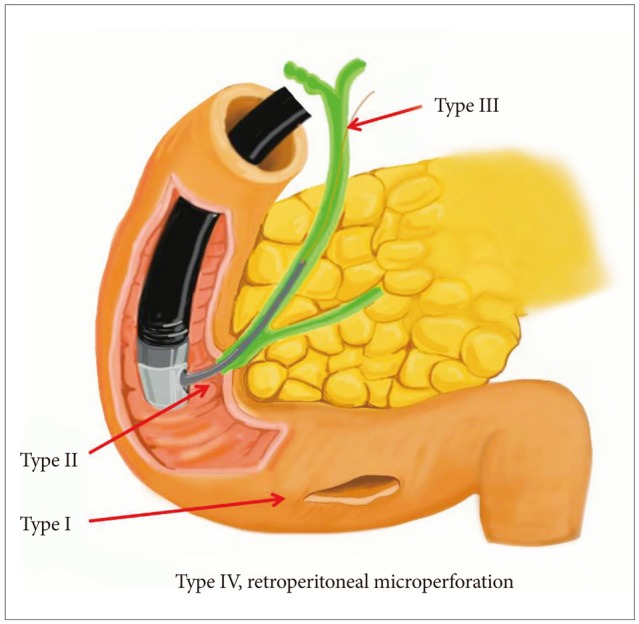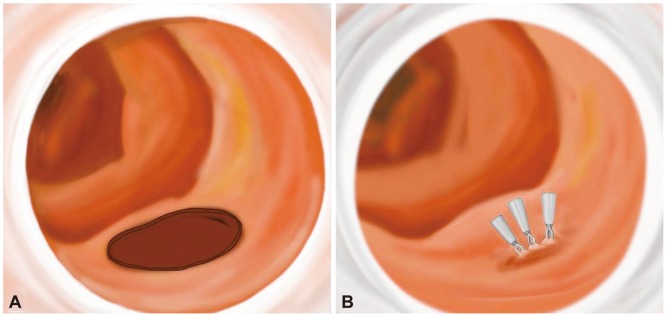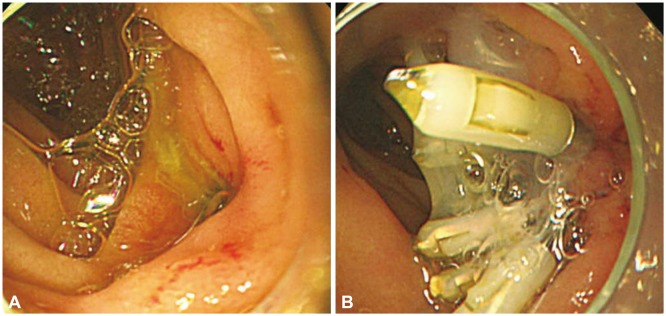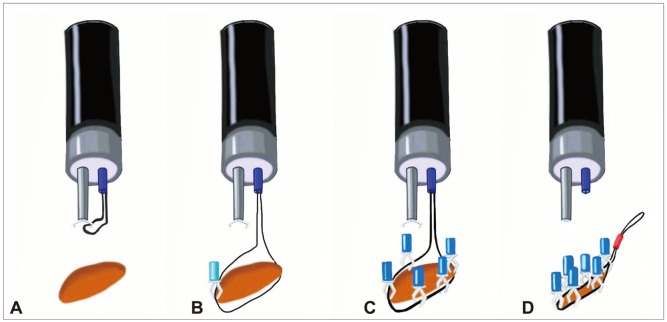1. Stapfer M, Selby RR, Stain SC, et al. Management of duodenal perforation after endoscopic retrograde cholangiopancreatography and sphin cterotomy. Ann Surg. 2000; 232:191–198. PMID:
10903596.
2. Howard TJ, Tan T, Lehman GA, et al. Classification and management of perforations complicating endoscopic sphincterotomy. Surgery. 1999; 126:658–663. PMID:
10520912.

3. Enns R, Eloubeidi MA, Mergener K, et al. ERCP-related perforations: risk factors and management. Endoscopy. 2002; 34:293–298. PMID:
11932784.

4. Assalia A, Suissa A, Ilivitzki A, et al. Validity of clinical criteria in the management of endoscopic retrograde cholangiopancreatography related duodenal perforations. Arch Surg. 2007; 142:1059–1064. PMID:
18025334.
5. Lee TH, Bang BW, Jeong JI, et al. Primary endoscopic approximation suture under cap-assisted endoscopy of an ERCP-induced duodenal perforation. World J Gastroenterol. 2010; 16:2305–2310. PMID:
20458771.

6. Vandervoort J, Soetikno RM, Tham TC, et al. Risk factors for complica tions after performance of ERCP. Gastrointest Endosc. 2002; 56:652–656. PMID:
12397271.
7. Freeman ML. Complications of endoscopic biliary sphincterotomy: a review. Endoscopy. 1997; 29:288–297. PMID:
9255535.

8. Krims PE, Cotton PB. Papillotomy and functional disorders of the sphincter of Oddi. Endoscopy. 1988; 20(Suppl 1):203–206. PMID:
3049058.

9. Wu HM, Dixon E, May GR, Sutherland FR. Management of perforation after endoscopic retrograde cholangiopancreatography (ERCP): a population-based review. HPB. 2006; 8:393–399. PMID:
18333093.

10. Miller G, Yim D, Macari M, Harris M, Shamamian P. Retroperitoneal perforation of the duodenum from biliary stent erosion. Curr Surg. 2005; 62:512–515. PMID:
16125609.

11. Melita G, Currò G, Iapichino G, Princiotta S, Cucinotta E. Duodenal per foration secondary to biliary stent dislocation: a case report and review of the literature. Chir Ital. 2005; 57:385–388. PMID:
16231831.
12. Sánchez-Tembleque MD, Naranjo Rodrìguez A, Ruiz Morales R, Hervás Molina AJ, Calero Ayala B, de Dios Vega JF. Duodenal perforation due to an endoscopic biliary prosthesis. Gastroenterol Hepatol. 2005; 28:225–227. PMID:
15811264.
13. Kaneko T, Akamatsu T, Shimodaira K, et al. Nonsurgical treatment of duodenal perforation by endoscopic repair using a clipping device. Gastrointest Endosc. 1999; 50:410–413. PMID:
10462667.

14. Katsinelos P, Paroutoglou G, Papaziogas B, Beltsis A, Dimiropoulos S, Atmatzidis K. Treatment of a duodenal perforation secondary to an endoscopic sphincterotomy with clips. World J Gastroenterol. 2005; 11:6232–6234. PMID:
16273659.

15. Baron TH, Gostout CJ, Herman L. Hemoclip repair of a sphincterotomy-induced duodenal perforation. Gastrointest Endosc. 2000; 52:566–568. PMID:
11023583.

16. Baron TH, Wong Kee, Zielinski MD, Emura F, Fotoohi M, Kozarek RA. A comprehensive approach to the management of acute endoscopic perforations (with videos). Gastrointest Endosc. 2012; 76:838–859. PMID:
22831858.

17. Han JH, Lee TH, Jung Y, et al. Rescue endoscopic band ligation of iatrogenic gastric perforations following failed endoclip closure. World J Gastroenterol. 2013; 19:955–959. PMID:
23429885.

18. Kim KW, Lee TH, Park SH, et al. a primary repair with hemoclips and fibrin glue injection in biliary stent induced duodenal perforation. Korean J Gastrointest Endosc. 2011; 42:437–441.
19. Marano BJ Jr, Bonanno CA. Metallic biliary endoprosthesis causing duodenal perforation and acute upper gastrointestinal bleeding. Gastrointest Endosc. 1994; 40(2 Pt 1):257–258. PMID:
8013842.

20. Mutignani M, Iacopini F, Dokas S, et al. Successful endoscopic closure of a lateral duodenal perforation at ERCP with fibrin glue. Gastrointest Endosc. 2006; 63:725–727. PMID:
16564890.

21. Seibert DG. Use of an endoscopic clipping device to repair a duodenal perforation. Endoscopy. 2003; 35:189. PMID:
12561015.

22. Sebastian S, Byrne AT, Torreggiani WC, Buckley M. Endoscopic closure of iatrogenic duodenal perforation during endoscopic ultrasound. Endoscopy. 2004; 36:245. PMID:
14986227.

23. Nakagawa Y, Nagai T, Soma W, et al. Endoscopic closure of a large ERCP-related lateral duodenal perforation by using endoloops and endoclips. Gastrointest Endosc. 2010; 72:216–217. PMID:
20304402.

24. Endo M, Inomata M, Terui T, et al. New endoscopic technique to close large mucosal defects after endoscopic mucosal resection in patients with gastric mucosal tumors. Dig Endosc. 2004; 16:372–375.

25. Matsuda T, Fujii T, Emura F, et al. Complete closure of a large defect after EMR of a lateral spreading colorectal tumor when using a two-channel colonoscope. Gastrointest Endosc. 2004; 60:836–838. PMID:
15557972.

26. Cotton PB, Lehman G, Vennes J, et al. Endoscopic sphincterotomy com plications and their management: an attempt at consensus. Gastrointest Endosc. 1991; 37:383–393. PMID:
2070995.
27. Vezakis A, Fragulidis G, Nastos C, Yiallourou A, Polydorou A, Voros D. Closure of a persistent sphincterotomy-related duodenal perforation by placement of a covered self-expandable metallic biliary stent. World J Gastroenterol. 2011; 17:4539–4541. PMID:
22110286.

28. Park WY, Cho KB, Kim ES, Park KS. A case of ampullary perforation treated with a temporally covered metal stent. Clin Endosc. 2012; 45:177–180. PMID:
22866262.

29. Kwon CI, Song SH, Hahm KB, Ko KH. Unusual complications related to endoscopic retrograde cholangiopancreatography and its endoscopic treatment. Clin Endosc. 2013; 46:251–259. PMID:
23767036.

30. Shi Q, Chen T, Zhong YS, et al. Complete closure of large gastric defects after endoscopic full-thickness resection, using endoloop and metallic clip interrupted suture. Endoscopy. 2013; 45:329–334. PMID:
23468195.

31. Aliperti G. Complications related to diagnostic and therapeutic endoscopic retrograde cholangiopancreatography. Gastrointest Endosc Clin N Am. 1996; 6:379–407. PMID:
8673333.

32. Saranga Bharathi R, Rao P, Ghosh K. Iatrogenic duodenal perforations caused by endoscopic biliary stenting and stent migration: an update. Endoscopy. 2006; 38:1271–1274. PMID:
17163332.

33. Esterl RM Jr, St Laurent M, Bay MK, Speeg KV, Halff GA. Endoscopic biliary stent migration with small bowel perforation in a liver transplant recipient. J Clin Gastroenterol. 1997; 24:106–110. PMID:
9077729.
34. Mastorakos DP, Milman PJ, Cohen R, Goldenberg SP. An unusual complication of a biliary stent-small bowel perforation of an incarcerated hernia sac. Am J Gastroenterol. 1998; 93:2533–2535. PMID:
9860420.

35. Coppola R, Masetti R, Riccioni ME, et al. Early retroduodenal perforation following endoscopic internal biliary drainage. Endoscopy. 1993; 25:255–256. PMID:
8519251.

36. Humar A, Barron PT, Sekar AS, Lum A. Pancreatitis and duodenal perforation as complications of an endoscopically placed biliary stent. Gastrointest Endosc. 1994; 40:365–366. PMID:
8056245.

37. Lee TH, Park SH, Son BS, et al. Four cases of guidewire induced periampullary perforation during endoscopic retrograde cholangiopancreatography. Korean J Gastrointest Endosc. 2011; 42:334–340.










 PDF
PDF ePub
ePub Citation
Citation Print
Print



 XML Download
XML Download